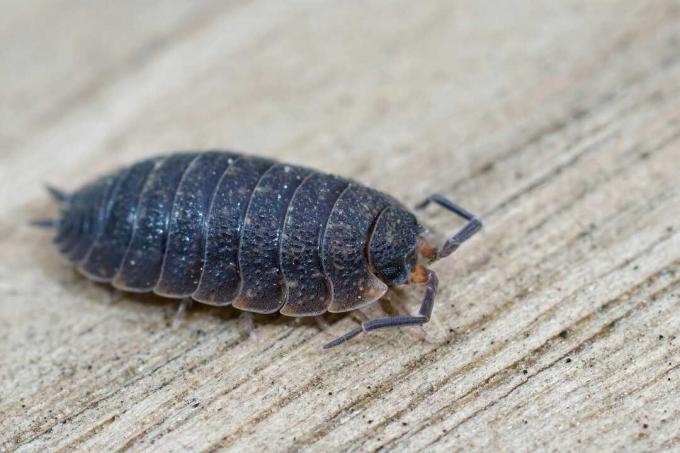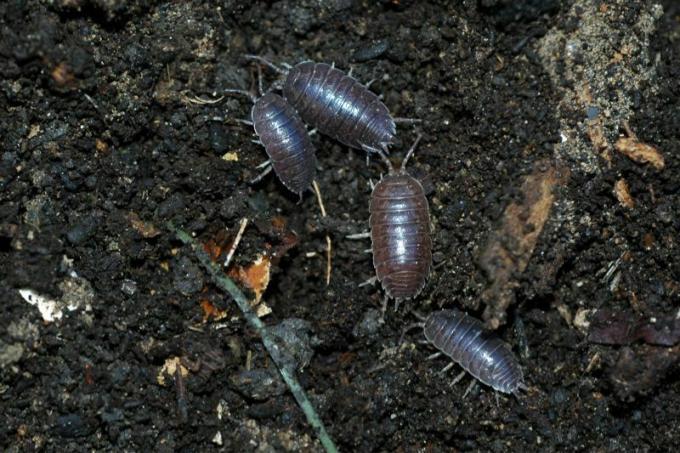
Woodlice can be found in all dark, damp and cool places. They can also get lost in the raised bed and multiply massively there if the living conditions are good. Learn how to get rid of them here.
In a nutshell
- Woodlice are harmless, but can eat plants
- eat dead plant parts
- only very many animals cause damage
- traps or lures
Table of contents
- living conditions in the raised bed
- Prevent woodlice
- Catch woodlice with attractants
- Traps for Woodlice
- Use repellents and poisons
- frequently asked Questions
living conditions in the raised bed
Not every raised bed is covered in woodlice (porcellio scaber) visited. It depends on where it is and how it is cared for. Woodlice depend on the following living conditions:
- dark hiding places
- moist to wet environment
- dead plant material as food

So if a raised bed is very sunny and mostly kept dry, it is not suitable for woodlice. However, if it tends to waterlogging and is also partially shaded or shaded, the isopods will find ideal living conditions. In such cases, it can also happen that the isopods, which are not actually pests, start eating potatoes or root vegetables. The more food they need and the less they find, the more likely they are to eat living plants.
Prevent woodlice
So that woodlice do not even visit a raised bed, there are a few things to consider:
- keep the soil as dry as possible
- Water plants directly at the roots
- Loosen mulch and soil regularly
- Remove plant debris
- Set up a raised bed in the sun
A notice: A layer of mulch protects the bed from drying out, but can attract woodlice.
Catch woodlice with attractants
Catching the woodlice with various attractants is one way to remove them from the raised bed. After that, they have to be released elsewhere in the garden.
The following lures may work:
- damp cloths (e.g. kitchen towels)
- Potato pieces (raw or cooked)

Directions:
Simply place the towels or pieces of potato in a shady spot on the soil of the raised bed. Leave them there overnight and collect the woodlice that have gathered there the next day and release them again in nature.
Repeat the process until the number of animals noticeably decreases.
Traps for Woodlice
Normally, woodlice traps are designed in such a way that they catch the animals but do not kill them. In this case, too, they must be released elsewhere. Also, traps work better with a lure.

Possible traps:
- glasses
- flowerpots
Directions:
If lures don't work so well, for example because the animals disappear again too quickly, traps from which they don't want to escape or can better help.
- dig a larger mason jar into the soil of the raised bed
- top edge should be flush
- Place raw potatoes or moist compost in the jar
- Empty and refill the glass every day
- Alcohol also attracts woodlice, but they drown in it
- Fill flower pots with wood shavings
- crumpled damp kitchen towels can also work
Use repellents and poisons
Chemical agents should not be used against woodlice in the vegetable patch. The risk of the funds being transferred to the vegetables is too great. Beneficial insects and other animals that are in the bed could also be harmed by the poison.
rock flour
In contrast to chemical poisons, rock dust is not poisonous. It blocks the isopods' airways, causing them to suffocate. Otherwise, however, it is not dangerous for the plants in the bed, instead it enhances the soil with minerals. Rock flour also protects against some plant diseases. If there are a lot of woodlice in the bed, it is easiest to spread the rock dust in the nooks and crannies where the animals congregate.
A notice: In order for it to be effective, the rock flour should be as fine and dry as possible.
Sage against woodlice
The isopods should not like the smell of sage. Therefore, the laying out of sage leaves make sure the animals go away. Planting a sage plant in a raised bed can also have the same effect.

frequently asked Questions
No, woodlice do not transmit diseases and cannot harm people. However, they still arouse feelings of disgust in many people. You can both in the garden and appear in the house. There are also various ways to get rid of the small animals in the house.
Yes, various insectivores. For example songbirds, hedgehogs or shrews. Some of them also come into the raised bed and it makes sense to attract them with a garden that is as natural as possible.
This includes harvestable potatoes, but also rotten tubers. Also various root vegetables. In the raised bed, however, these plants are only eaten if there is not enough other dead plant material. If there are a lot of woodlice, they sometimes also eat flower stalks.
